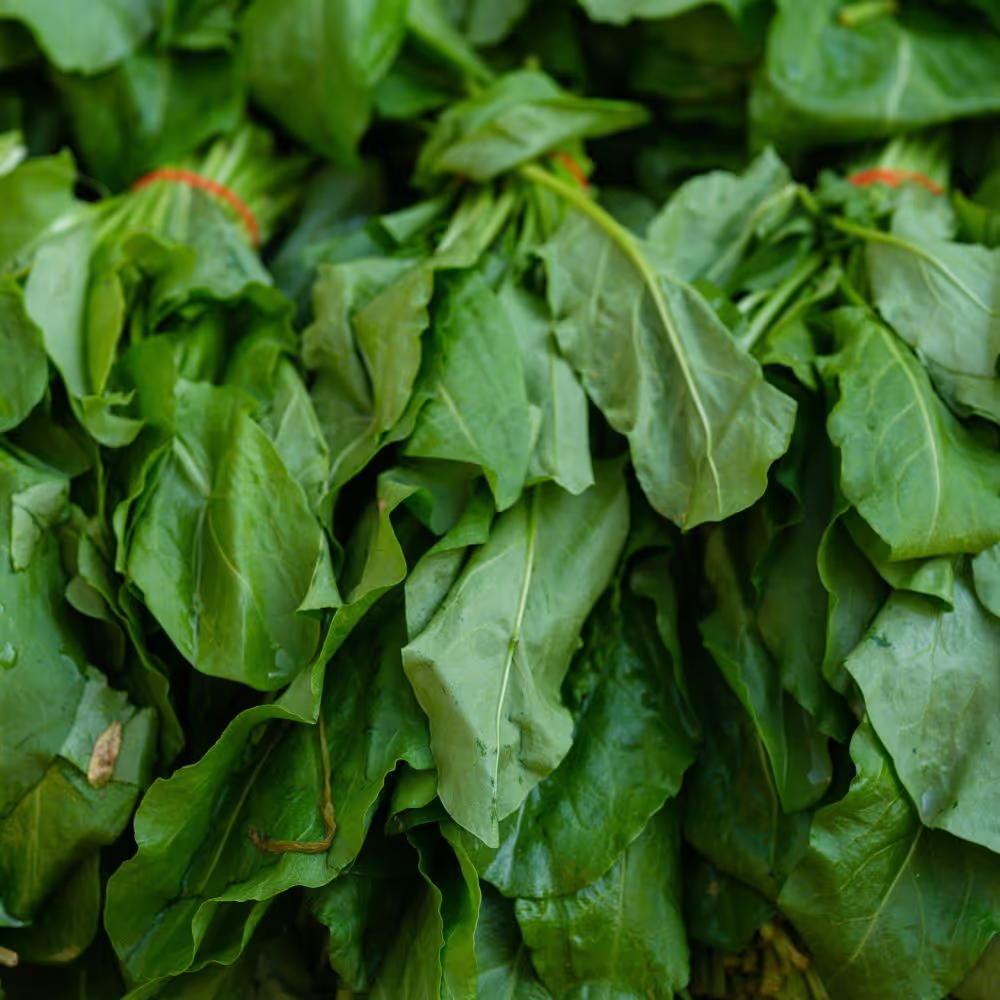What Does it Taste Like?
Spinach has a mild and slightly sweet flavor that can vary depending on the variety. There are three main types of spinach: savoy, semi-savoy, and flat-leaf. Savoy spinach has curly and crinkly leaves, semi-savoy spinach has slightly curly and textured leaves, and flat-leaf spinach has smooth and broad leaves. Savoy and semi-savoy spinach tend to have a more earthy and bitter flavor, while flat-leaf spinach tends to have a more delicate and sweet flavor. Baby spinach is simply flat-leaf spinach harvested when it's still young so the texture is softer and ideal for eating raw.
Varieties we grow

Rangitoto
Rangitoto spinach is a vibrant, deep green variety known for its smooth, oval leaves and sturdy stems. Its texture is tender yet robust, making it ideal for both fresh salads and cooked dishes. The flavor is mild and slightly sweet, with a hint of earthiness, offering a versatile and nutritious addition to various culinary creations.
Why Should I Eat It?
Spinach is one of the more nutrient rich leafy greens out there. The tender baby greens make a great, healthy swap for lettuce in salads for an added nutritional boost.
- It is low in calories and high in water, which can help you stay hydrated and feel full. One cup of raw spinach has only 23 calories and 91% water.
- It's rich in vitamin K, which is essential for blood clotting, bone health, and antioxidant activity. One cup of raw spinach provides 169% of the Reference Daily Intake (RDI) for vitamin K.
- Spinach is a good source of vitamin A, especially green varieties, which contain beta-carotene, a precursor of vitamin A. Vitamin A is important for vision, immunity, and skin health. One cup of raw spinach provides 13% of the RDI for vitamin A.
- It's got a lot of vitamin C, which is a powerful antioxidant that promotes skin health and immune function. One cup of raw spinach provides 10% of the RDI for vitamin C.
- It's a good source of folate, which is also known as vitamin B9. Folate is essential for DNA synthesis, cell division, and brain function. It is especially important for pregnant women, as it can prevent neural tube defects in the developing fetus. One cup of raw spinach provides 7% of the RDI for folate.
- Spinach is high in iron, which is a mineral that helps create hemoglobin, which brings oxygen to your body’s tissues. One cup of raw spinach provides 5% of the RDI for iron.
- It is a good source of magnesium, which is a mineral that regulates muscle and nerve function, blood sugar levels, and blood pressure. One cup of raw spinach provides 5% of the RDI for magnesium.
- It contains various phytochemicals, such as flavonoids, phenolic acids, and terpenes, that can protect the cells from oxidative stress and inflammation. Some of these phytochemicals may also have anti-cancer, anti-diabetic, and anti-obesity effects.
Spinach

May - December
Spinach is one of the most popular and versatile leafy greens in the world. It is a flowering plant that belongs to the same family as beets, chard, and quinoa. It originated in central and western Asia, but is now grown and eaten around the world. Spinach is widely used in various cuisines, such as Mediterranean, Indian, Chinese, and Japanese. It can be eaten raw or cooked, in salads, soups, smoothies, pies, and more.
Recommended Storage
How Do I Store It?
Short Term
Wash and dry the spinach thoroughly before storing it. You can use a salad spinner or a paper towel to remove excess moisture, which can cause it to wilt and rot faster. Wrap the lettuce in a paper towel or a cloth and place it in a plastic bag or an airtight container. The paper towel or cloth will absorb any residual moisture and prevent the lettuce from getting soggy. Store the it in the refrigerator, preferably in the crisper drawer.
Long Term
- Freezing: You can freeze washed, raw spinach either in whole-leaf form or pureed for smoothies, or blanch the whole leaves before freezing to lock in more of the nutrients. The crisp texture won't hold up in the defrosting process, so only use frozen spinach in dishes where the spinach would be well cooked anyway.
- Canning: You certainly can can spinach using a pressure canner, but it will come out with a rather soggy, slimy texture.
How Do I Cook It?
There are, unfortunately, entire generations of people who only know spinach in it's canned, mushy, stinky form. If this happens to be you, you should definitely give cooking with fresh spinach a try. The difference in taste between fresh and canned, or even frozen for that matter, is like night and day.
- Raw: The tender "baby" leaves of a spinach are best when served raw, like in a salad or sandwich.
- Sautéing: Sautéing spinach in a skillet with oil and seasonings can create a quick and easy side dish or stir-fry. Sautéed spinach has a tender and savory flavor and texture. To sauté spinach, heat some oil in a skillet over medium-high heat. Add the spinach and your choice of seasonings, such as garlic, onion, salt, pepper, lemon juice, etc. Cook for about 5 minutes, stirring occasionally, until the spinach is wilted and bright green. Be warned, though, spinach shrinks significantly when it wilts. So, if your recipe calls for what seems to you to be an insane amount of raw spinach, it probably isn't.
- Steaming: Steaming spinach in a steamer basket over boiling water can preserve the nutrients and color of the spinach. Steamed spinach has a crisp and fresh flavor and texture. To steam spinach, bring a large pot of water to a boil and place a steamer basket over it. Add the spinach to the basket and cover with a lid. Steam for about 3 minutes, or until the spinach is wilted and bright green. You can season the spinach with salt, pepper, lemon juice, or your favorite dressing.
- Baking: Baking spinach in the oven with cheese, eggs, cream, and other ingredients can create a delicious and filling casserole or quiche. Baked spinach has a rich and cheesy flavor and texture. To bake spinach, preheat the oven to 375°F and grease a baking dish. In a large bowl, whisk together some eggs, cream, cheese, salt, pepper, and nutmeg. Add the spinach and mix well. Pour the mixture into the prepared baking dish and bake for 25 to 35 minutes, or until golden and set.

What Goes Well With It?
Spinach has a mild and slightly sweet flavor that can pair well with many other ingredients. Here are some of the best flavor pairings for spinach;
- Dairy: Dairy brings a creamy richness and sweetness to spinach. You can pair spinach with milk, cream, yogurt, butter, and cheese. Some of the best cheeses to pair with spinach are feta, goat cheese, ricotta, Parmesan, and mozzarella. You can use dairy and spinach in soups, sauces, dips, casseroles, and more.
- Fruit: Spinach and fruit creates a refreshing and healthy combination that can add some sweetness and acidity to the spinach. Some of the best fruits to pair with spinach are apple, pear, strawberry, orange, and grapefruit.
- Nuts: Nuts add some protein and healthy fats to the spinach, along with a lovely crunchy texture. Some of the best nuts to pair with spinach are almond, walnut, pine nut, pistachio, and pecan.
- Herbs: Herbs and spinach are a fresh and fragrant pair. Herbs will bring some additional flavor and aroma to spinach dishes. Some of the best herbs to pair with spinach are basil, mint, parsley, cilantro, and dill.
- Bacon and lemon: You may already be familiar with the rich, smokey combo of bacon and spinach. But by tossing bright and tangy lemon into the mix, you create a much balanced and flavorful combination as the lemon helps mellow out some of that richness and adds some much needed depth. You can use the combo of bacon and lemon in spinach based salads, pastas, quiches, and more.
- Garlic: Garlic and spinach are a flavorful and aromatic pair that can add some punch and depth to the spinach. Garlic can enhance the sweetness and earthiness of spinach, while spinach can balance the pungency and spiciness of garlic. You can use garlic and spinach in stir-fries, sautés, pesto, and more.
- Mustard: Mustard and spinach are a spicy and pungent pair that can add some heat and complexity to the spinach. Some of the best mustards to pair with spinach are Dijon, honey, whole grain, and horseradish. You can use mustard and spinach in dressings, sandwiches, wraps, and more.
